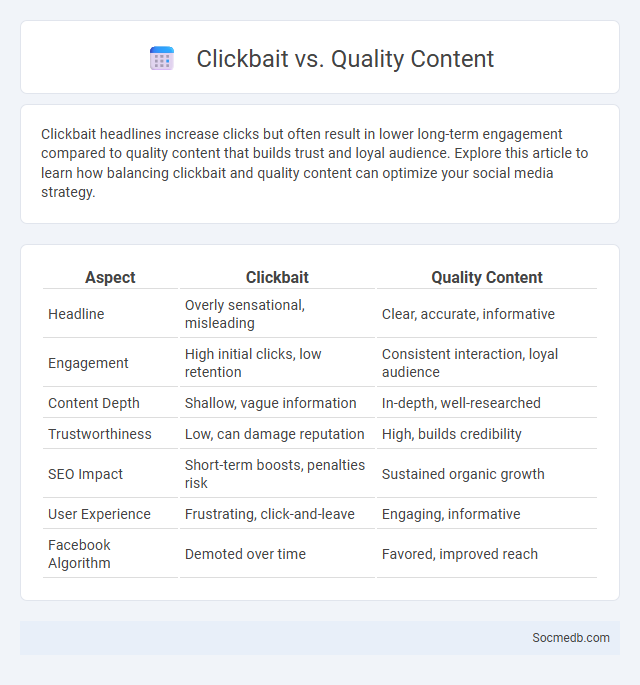
Photo illustration: Clickbait vs quality content
Clickbait headlines increase clicks but often result in lower long-term engagement compared to quality content that builds trust and loyal audience. Explore this article to learn how balancing clickbait and quality content can optimize your social media strategy.
Table of Comparison
| Aspect | Clickbait | Quality Content |
|---|---|---|
| Headline | Overly sensational, misleading | Clear, accurate, informative |
| Engagement | High initial clicks, low retention | Consistent interaction, loyal audience |
| Content Depth | Shallow, vague information | In-depth, well-researched |
| Trustworthiness | Low, can damage reputation | High, builds credibility |
| SEO Impact | Short-term boosts, penalties risk | Sustained organic growth |
| User Experience | Frustrating, click-and-leave | Engaging, informative |
| Facebook Algorithm | Demoted over time | Favored, improved reach |
Understanding Clickbait: Definition and Tactics
Clickbait refers to sensationalized or misleading headlines and content designed to attract clicks and increase online traffic by exploiting users' curiosity. Common tactics include exaggeration, emotional triggers, and withholding key information to compel users to engage without delivering promised value. Understanding these strategies helps social media users critically assess content and avoid falling for deceptive links or misinformation.
What Defines Quality Content?
Quality content on social media is defined by relevance, engagement, and authenticity, capturing the audience's interest through valuable and shareable information. High-quality posts feature clear visuals, compelling storytelling, and consistent messaging that aligns with the brand's voice and audience preferences. Metrics such as likes, shares, comments, and conversion rates serve as indicators of content effectiveness and resonance with the target demographic.
Key Differences Between Clickbait and Quality Content
Clickbait often relies on sensationalist headlines and misleading information to drive clicks, prioritizing quantity over content accuracy, while quality content provides valuable, accurate, and relevant information that meets audience needs. Engagement metrics for clickbait may spike briefly but tend to generate low trust and poor retention, unlike quality content which builds long-term audience loyalty through credibility and depth. Effective social media strategies emphasize content that balances compelling visuals and headlines with substantive, well-researched material to enhance user experience and brand reputation.
The Psychology Behind Clickbait Appeal
Clickbait leverages psychological triggers such as curiosity gap, emotional arousal, and social proof to compel users to click on content. Your brain's desire to resolve uncertainty and fear of missing out (FOMO) are exploited by sensational headlines and provocative images designed to capture attention quickly. Understanding these mechanisms can help you recognize and resist manipulative tactics in social media feeds.
Impact of Clickbait on Reader Trust
Clickbait headlines significantly erode reader trust by promising sensational content that often fails to deliver, leading to disappointment and skepticism. Studies show that repeated exposure to misleading clickbait reduces users' confidence in news sources and decreases long-term engagement. Platforms employing transparent and accurate headline practices witness higher user retention and credibility perception.
SEO Implications: Clickbait vs Quality Content
Clickbait headlines may generate high click-through rates but often lead to increased bounce rates and lower user engagement, negatively impacting your SEO rankings. Search engines prioritize quality content that provides real value, in-depth information, and satisfies user intent, boosting your website's authority and visibility. Your social media strategy should focus on creating authentic, well-researched posts that attract organic traffic and foster long-term audience trust.
Strategies for Creating Engaging Yet Authentic Content
Crafting engaging yet authentic social media content requires a deep understanding of your target audience's interests and values to ensure relevance and resonance. Use storytelling techniques paired with genuine experiences to build trust and foster meaningful connections without compromising authenticity. Monitoring engagement metrics and feedback allows you to refine your approach, enhancing content effectiveness while staying true to your brand's voice.
How Clickbait Affects Brand Reputation
Clickbait tactics often damage brand reputation by fostering distrust among consumers who feel misled by exaggerated or false headlines. Studies show that 70% of users avoid brands that repeatedly use clickbait, leading to decreased customer loyalty and negative word-of-mouth. Maintaining transparent and accurate messaging is crucial for sustaining a positive brand image in the competitive social media landscape.
Measuring Success: Metrics for Clickbait and Quality Content
Measuring success on social media requires analyzing key metrics such as click-through rates, engagement rates, and bounce rates to differentiate between clickbait and quality content. High engagement rates combined with longer average view durations generally indicate valuable and authentic content, whereas clickbait typically shows high initial clicks but low retention and interaction quality. Monitoring sentiment analysis and user feedback further enhances understanding of content impact beyond superficial metrics.
Future Trends: Balancing Clickbait and Authenticity in Content Creation
Future trends in social media emphasize a strategic balance between clickbait tactics and authentic content creation to maintain user trust and engagement. Algorithms increasingly favor genuine, value-driven posts over sensational headlines, encouraging creators to prioritize quality and transparency. Your success in social media marketing will depend on mastering this equilibrium to build lasting audience connections while driving traffic effectively.
 socmedb.com
socmedb.com